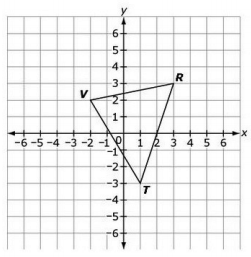Clusters should not be sorted from Major to Supporting and then taught in that order. To do so would strip the coherence of the mathematical ideas and miss the opportunity to enhance the major work of the grade with the supporting clusters.
- Assessment Limits :
Items may require the student to be familiar with using the algebraic
description for a translation, and
for a translation, and for a dilation when given the center of dilation.
for a dilation when given the center of dilation.
Items may require the student to be familiar with the algebraic
description for a 90-degree rotation about the origin, , for a 180-degree rotation about the origin,
, for a 180-degree rotation about the origin, , and for a 270-degree rotation about the origin,
, and for a 270-degree rotation about the origin, . Items that use more than one transformation may
. Items that use more than one transformation may
ask the student to write a series of algebraic descriptions. - Calculator :
Neutral
- Clarification :
Students will use the definition of similarity in terms of similarity
transformations to decide if two figures are similar.Students will explain using the definition of similarity in terms of
similarity transformations that corresponding angles of two figures
are congruent and that corresponding sides of two figures are
proportional. - Stimulus Attributes :
Items may be set in a real-world or mathematical context - Response Attributes :
Items may ask the student to determine if given information is
sufficient to determine similarity.
- Test Item #: Sample Item 1
- Question:
Triangle RTV is shown on the graph.

Triangle R'T'V' is formed using the transformation (0.2x, 0.2y) centered at (0,0).
Select the three equations that show the correct relationship between the two triangles based on the transformation.
- Difficulty: N/A
- Type: MS: Multiselect
Related Courses
Related Access Points
Related Resources
Formative Assessments
Lesson Plans
Perspectives Video: Professional/Enthusiast
Problem-Solving Tasks
Text Resource
Virtual Manipulative
Worksheet
MFAS Formative Assessments
Students are asked to use the definition of similarity in terms of similarity transformations to determine whether or not two quadrilaterals are similar.
Students are given the definition of similarity in terms of similarity transformations and are asked to explain how this definition ensures the equality of all corresponding pairs of angles and the proportionality of all corresponding pairs of sides.
Students are asked to use the definition of similarity in terms of similarity transformations to determine whether or not two triangles are similar.
Student Resources
Perspectives Video: Professional/Enthusiast
Don't be a shrinking violet. Learn how uniform scaling is important for candy production.
Type: Perspectives Video: Professional/Enthusiast
Problem-Solving Task
In this problem, students are given a picture of two triangles that appear to be similar, but whose similarity cannot be proven without further information. Asking students to provide a sequence of similarity transformations that maps one triangle to the other, using the definition of similarity in terms of similarity transformations.
Type: Problem-Solving Task
Parent Resources
Perspectives Video: Professional/Enthusiast
Don't be a shrinking violet. Learn how uniform scaling is important for candy production.
Type: Perspectives Video: Professional/Enthusiast
Problem-Solving Task
In this problem, students are given a picture of two triangles that appear to be similar, but whose similarity cannot be proven without further information. Asking students to provide a sequence of similarity transformations that maps one triangle to the other, using the definition of similarity in terms of similarity transformations.
Type: Problem-Solving Task









